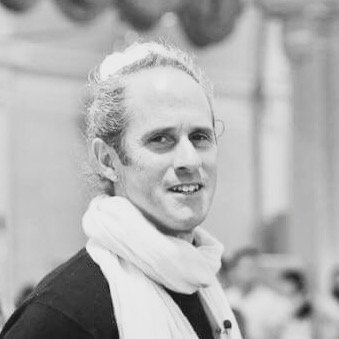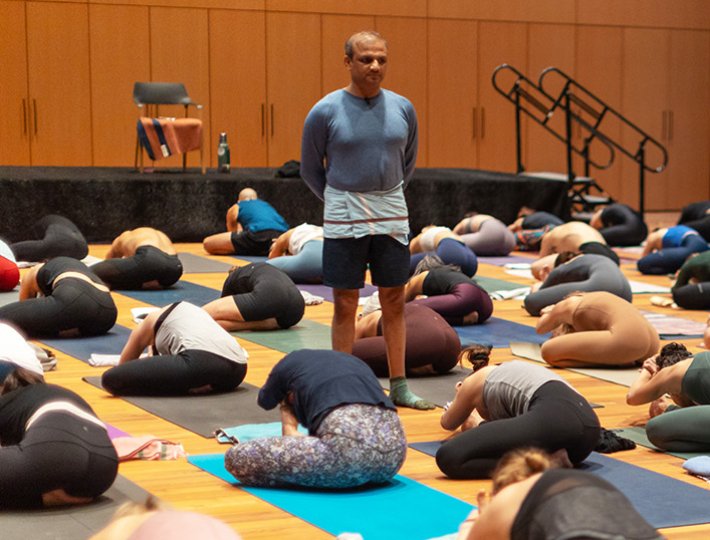Over many years of following the Aṣṭāṅga yoga method, I have found that devotional practices, particularly chanting and japa (meditation in the form of silent mantra repetition often using the name of a deity), have become an indispensable part of daily practice. This strengthening of the bhāvana of devotion is very helpful in overcoming many of the internal obstacles that arise in yoga practice. Most importantly, it helps to strengthen saṃtoṣa (contentment) and reduces the tendency of striving to achieve external goals as practice becomes more internally oriented.
Since the nature of the mind is so subtle, it is extremely hard to bring it under control. Language can be a very useful tool in this regard as it is a vital aspect of the functioning of the mind. Using the power of words and sounds to create strong mental impressions is profoundly impactful, perhaps more so than visual stimuli. Upon hearing a word, the mind is immediately presented with an image associated with that object, along with many other associations and emotions.
In yoga philosophy, vikalpa (a vṛtti or mental function) is imagination defined by Patañjali as “knowledge derived from words when the object is absent.” Hence, language and words can be potent tools in yoga, too. Japa, the practice of mantra repetition using appropriate words (śabdha) or expressions, can help temper our mental activities, such as stress and anxiety. There is a large and well-developed methodology within the realm of yoga therapy that uses japa to correct and heal inappropriate thought patterns and, ultimately, bring the mind into a state that is able to guide us inward for the purpose of yoga. In India, the importance of japa and mantra has been recognized for thousands of years. One of the the most highly regarded meditation techniques being the silent repetition of Oṃ, or praṇava, known as Oṃkāra japa.
Philosophical literature also describes in many works the meaning and use of Oṃ as a sādhana, particularly in the Vedas and Upanishads (see the Māṇḍūkya Upaniṣad). From the yoga perspective, Patañjali defines Oṃ as the śabdha (word or expression) that represents īśvara. He lists devotion (praṇidhāna) to īśvara as the primary solution in yoga that allows the overcoming of obstacles. His use of the word praṇidhāna indicates devotion in the form of profound meditation on—and vehement desire for—īśvara.
He also defines īśvara as “a special puruṣa (soul) who is beyond all karma and its results,” “the seed or source of all knowledge,” and “the guru for all gurus in all time.” His form is said to be represented by the sound Oṃ, and Oṃkāra japa is said to reveal the light of consciousness within as well as being the most effective tool for the removal of internal obstacles. In his work Dhyānamālika, yoga teacher, Ayurvedic healer, and scholar Tirumalai Krishnamacharya defines īśvara further saying that he is the antaryāmi (literally translating as the inner controller; synonymous with Brahman), which is the size of the thumb and dwells within the center of the ātman (soul.)
Related: Embracing and Overcoming Obstacles in Yoga
Krishnamacharya also describes the significance of using a correct object for meditation. Stating that in the science of yoga, the dhyeya (an object fit for meditation) “can only be the paramātma (īśvara)” and that “we should surrender to him.” He also emphasizes that while in a state of dhyānam (meditation), one should praise his greatness and that this bhāvana (feeling) should always be present.
For a large number of practitioners, particularly those of us from outside of the vedic tradition, a more tangible practice may be needed before attempting a technique such as Oṃkāra japa. Depending on the subject’s spiritual orientation and capacity, there are many other options, such as using Rāma, Śiva or Christ as a way to make an initial connection to a form associated with divinity that, ultimately, leads to the same end.
Other mantras, such as those utilized in the TM meditation technique of Maharishi Mahesh Yogi, are said to have no associations with any religious form, but can still be highly effective when the right mantra is prescribed. It is also believed to be imperative to be instructed in japa by one who has mastered the mantra, otherwise, the results will not bear fruit. Furthermore, as with all yoga techniques, the process of learning japa should be overseen by an experienced guru or teacher who can take into account each individual students needs while monitoring the process of learning and practicing of the technique.
A daily chanting practice of mantras and devotional songs (in addition to japa), especially in a group setting, is also an excellent way to create the bhavana of which Krishnamacharya speaks in Dhyānamālika. It is very helpful in changing the focus from an orientation of material achievement in yoga toward a practice more devotional in nature. This is something that can easily enter into other aspects of life. It is an invaluable tool for relinquishing the ego as well as directing focus and a sense of love to those positive qualities that are represented in the divine. Bringing both joy and surrender which in turn, can produce a sense of being supported in life, promoting acceptance and an appreciation for “what is.”








Comments (0)